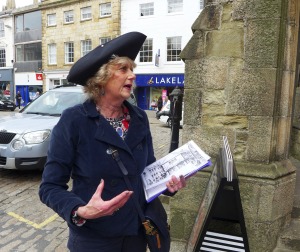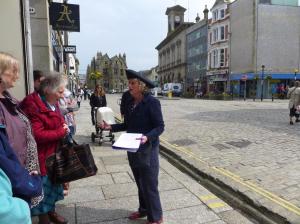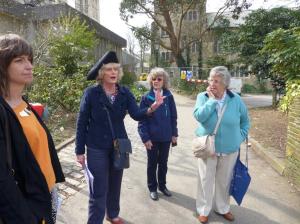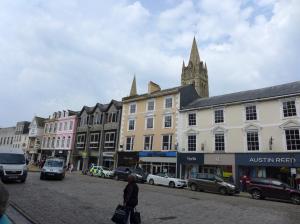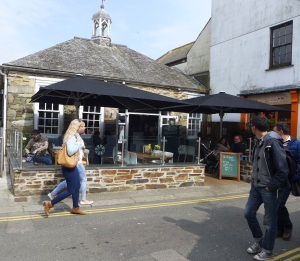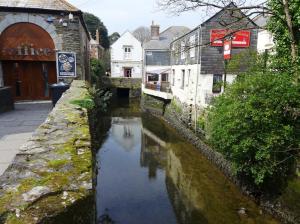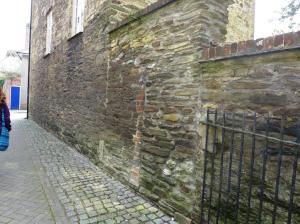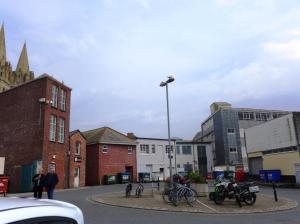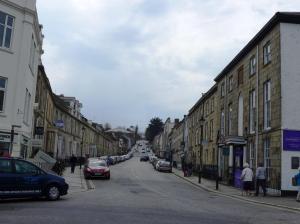I have not read the books and have started watching the TV series, however I have had the pleasure in visiting sites in Truro frequented by the fictional hero Ross Poldark in this 18th century coinage Town.
Viv Robinson of Absolutours conducted the tours this April in her unmistakable Poldark tricorn hat! Viv bought the story to life and enabled us to imagine what life was truly like for those who lived during that time.
Winston Graham is the author of the books, along with the popular television programme and has enticed audiences into the romanticism of their love of Cornwall’s natural beauty. Viv assures us, that the author tried to write as near to the truth of what life was like in his 18th century novels. This you can glean from the books.
We discover that Poldark’s Truro was filmed in the port of Charlestown which is where the characters of the book come and buy their fresh produce, go shopping, gambling, banking and to the ‘Red Lion’ pub (The Co-Operative on Boscawen Street) in Truro.
Poldark was based between 1783 and 1790, when Truro was just a town – there was no cathedral but there was a port. During this time Truro looked very different. The Red Lion pub had a large mahogany staircase (now in Godolphin House) and it had many rooms and was impressive.
During the story, The Poldark family name was long established but the ‘nuwe’ rich were the up and coming working class, such as the Warleggan’s who rose from being blacksmiths to mine owners and then bankers. There was a small prison in Truro called a clink and many who were convicted after waiting for trial here were then sent to Bodmin, much larger prisons or deported to Australia. There were many poor people who were sentenced harshly for small crimes.
I discovered that coinage hall (Charlotte’s Tea House) , as it stands today, is not the original building and was rebuilt. Truro was a coinage town and this gave it some prominence and stature. The tin was bid upon at ticketings held in the Red Lion and then went on to the smelters. On coinage days smelted tin was bought from mines such as St Agnes into Truro and the blocks were weighed and stamped with the seal of the crown to whom taxes would be paid. This was necessary before tin could be exported. From looking down at Boscawen Street from coinage hall, the street is wide, however there used to be a middle row of houses, which are no longer there.
Cathedral Lane was originally called Church lane and was full of trade’s people, this led to St Marys Church which was built in 1548 and now nestles in the Cathedral which was built in 1880. Along St Marys Street, is the Old Grammar School, which was considered to be the ‘Eton’ of Cornwall, where professional classes would learn. The famous artist, John Opie was discovered by Dr Wolcott who attended this school and fictional characters Ross and Francis Poldark also studied here.
Truro was much smaller then and had a new bridge (New Bridge Street) and an old bridge (Old Bridge Street) across the Allen River. Where the cathedral was, there was industry, carpet makers, millers and many pubs, such as the Bear Inn (opposite The Baking Bird, where only a few bricks remain). During this time the cost of bread was high and people were hungry and there were often food riots.
The Assembly rooms (Warrens Bakery and Acorn Recruitment) is where grand balls were held, this building was unique and was used for enjoyment. There was a theatre inside, with the emblems of Thalia, the muse of comedy, David Garrick and William Shakespeare on the façade of the building. Truro at this time was trying to rival Bath. Highcross was the old churchyard and the Warleggan family of Poldark’s (BHS) town house was close by.
Cock fighting was extremely popular during this time and there were several cock pits in Truro, one being on the circle outside B Juicy Café and Lunch Café.
Pydar Street was a popular residential street and the closer you lived to town the grander the houses were. Kenwyn Street is referred to in Poldark where all the shopping is done. The Warleggans were an example of a ‘nuwe’ rich family, who originally earned their money as blacksmiths. They had a carriage, with footman and this was rare in those days, not many people had carriages and there is a piece in the book where people admire the carriage outside the Warleggan’s town house.
Walking through Roberts Ope (Breathe) you can see the Kenwyn River where boats would sail down and the banks of the river would be muddy and smelly. Houses (The White Store) would then view what boats were in Truro. In 1798 the bridge was built and Mannings Hotel is close to where the commercial hub of Truro was. In 1799, a new route was opened up from the west and Lemon Street was built and the Lemon Street Market provided stabling for carriages and horses as they came in off the road.
The Dolphin Pub lies opposite the corner of Green Street (Handelsbanken) and used to be a popular refreshment venue. In 1706, Samuel Enys, a merchant from Penryn, built the house, now known as ‘The Bridal House of Cornwall’, which was a grand residence where you could view the ships. Princes Street held the grandest houses during that time, Princes House was built in 1740. Next door Mount Fuddle (Wearhouse) and the Mansion House, made with Bath stone can be found.
Truro is a Georgian city with Victorian architecture. I relished going on this walking tour, it brought the Poldark story to life. I enjoyed finding out the history of Truro and the little taste of what life was like during that period.
Viv and team of Blue Badge guides will be running walking tours throughout the summer called, ‘Truro Now and Then’, from Wednesday the 6th May, 11am from Visit Truro Information Centre, Boscawen Street, Truro, TR1 2NE. Pre-booking advisable on 01872 274555 or tic@truro.gov.uk max 15 people Adults £6 and Children £3.50. These will then run every Wednesday until 30th September. Dates for the ‘Poldark walks’can also be obtained from Visit Truro Information Centre.

